Sous Vide Ribeye Steak – Perfectly Tender, Juicy & Foolproof
Sous vide ribeye steak isn’t just a trendy cooking technique—it’s a precision-driven method that transforms a good cut of meat into something truly extraordinary. In this guide, I’ll share exactly how to nail the timing, temperature, sear, and flavor of your ribeye every single time. Whether you’re chasing the perfect medium-rare or want a steakhouse crust right at home, this walkthrough has you covered. We’ll also compare sous vide to traditional grilling so you can choose what’s best for your next steak night.
A Family Steakhouse Memory, Reinvented
Hey there—I’m Enzo, and if there’s one thing I’ve learned over the years, it’s that a little patience and a perfectly heated water bath can work absolute miracles in the kitchen.
Growing up in my family’s Chicago deli, ribeye steaks were something special. We didn’t cook them often, but when we did, my dad would grab the thickest, marbled cuts and sear them until the whole shop smelled like Sunday dinner. It was loud, fast, and always delicious—but also a gamble. Sometimes we nailed that perfect medium-rare, other times not so much.
Years later, after a detour through music, bartending, and design gigs, I found myself craving that perfect ribeye again. Only this time, I wanted control. No more overcooked edges or guessing with a thermometer. That’s when I discovered sous vide—and it was like finding a cheat code.
The first time I sealed a ribeye and dropped it in the bath, I was skeptical. But three hours later, after a quick sear in a ripping hot pan, I sliced into a steak so tender, so evenly pink from edge to edge, it felt like culinary magic. Better yet, I could repeat it every time. That’s the beauty of sous vide ribeye steak: control, flavor, and consistency without stress.
If you’ve already tried my Sous Vide Flank Steak or Salt Beef Sous Vide, you’ll love how this method works for a premium cut like ribeye.
Why Sous Vide Works Wonders for Ribeye Steak
The magic behind sous vide ribeye steak lies in temperature precision. Unlike pan-frying or grilling—where heat comes from one direction and temperatures fluctuate—sous vide surrounds your steak with perfectly controlled warmth. That means your ribeye cooks evenly, without ever risking the dreaded gray ring of overdone meat.
Ribeye is marbled with fat, which makes it forgiving and flavorful, but traditional cooking can’t render that fat properly without risking dryness. Sous vide solves that. Set it to 129°F, let it bathe for 2–3 hours, and the steak comes out buttery and juicy with fat that’s started to melt into the meat. You’ll finish it with a quick sear, giving you that signature crust without overcooking the inside.
Plus, sous vide ribeye steak is a game-changer for dinner parties. You can prep hours in advance, hold the steaks warm in the bath, then sear and serve when guests arrive—just like a pro.
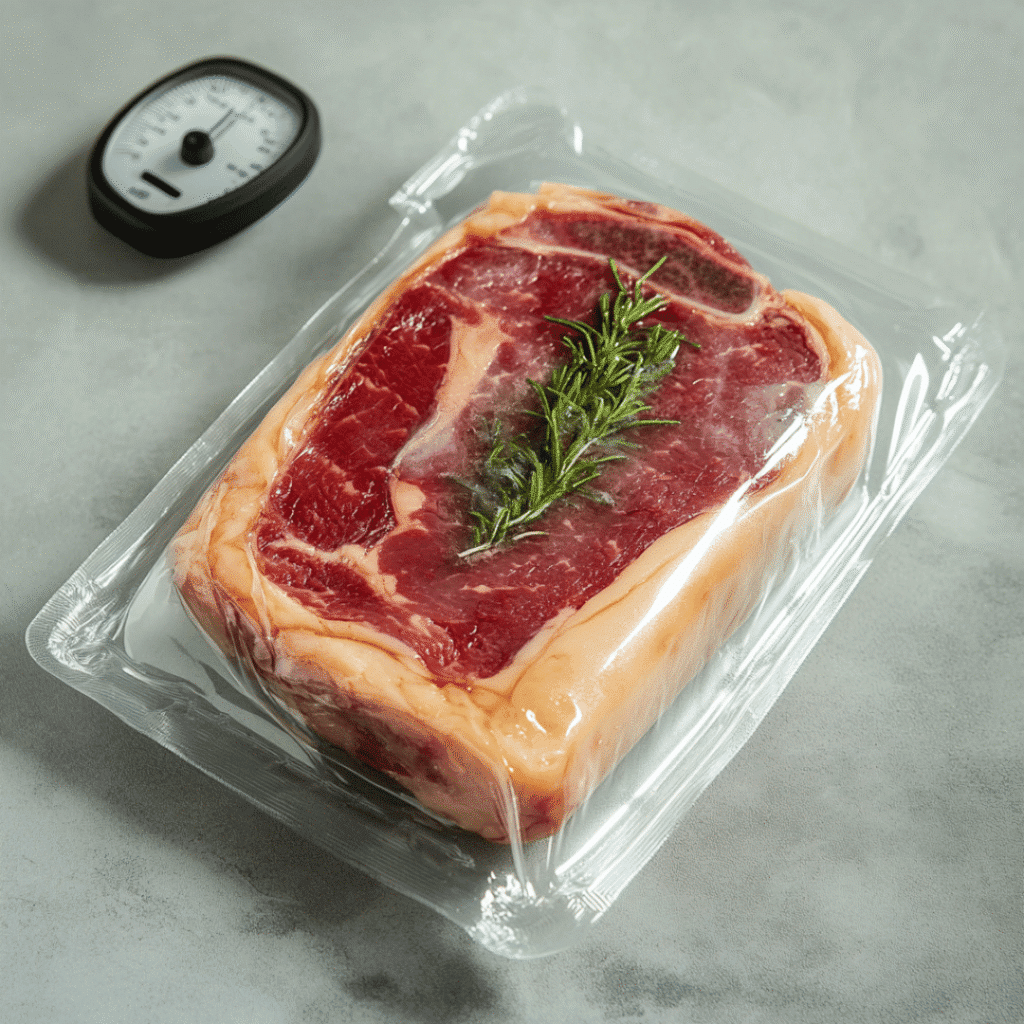
Mastering the Sous Vide Process for Ribeye
When it comes to getting sous vide ribeye steak just right, precision is everything. Luckily, the method is designed for repeatable, perfect results—so long as you follow a few basic rules. From how long to cook your steak to the exact temp for your ideal doneness, we’re breaking it all down here.
How Long to Sous Vide Ribeye for Perfect Texture
So, how long should you sous vide a ribeye steak? The answer depends on the thickness of your steak and how tender you want the final result to be. Generally speaking, most ribeye steaks need a minimum of 1 hour, but the sweet spot lies between 2 and 4 hours.
For a standard 1.5-inch ribeye, I always go with 2.5 hours at 129°F for perfect medium-rare. Want it fork-tender? You can extend the time up to 6 hours without compromising texture—but don’t go beyond that or the fibers start to get mushy.
Here’s a helpful guide:
| Doneness | Temperature | Cook Time |
|---|---|---|
| Rare | 122°F / 50°C | 1.5 – 2.5 hours |
| Medium-Rare | 129°F / 54°C | 2 – 3 hours |
| Medium | 135°F / 57°C | 2 – 3 hours |
| Medium-Well | 144°F / 62°C | 2.5 – 4 hours |
| Well Done | 154°F / 68°C | 2.5 – 4 hours |
For comparison, the same timing works beautifully for other proteins too—like Sous Vide Scallops and Salt Beef Sous Vide, proving how versatile sous vide can be.
Ideal Sous Vide Ribeye Steak Temperature Guide
Choosing the right temperature for sous vide ribeye steak depends on how you like your steak done—and how you define “perfect.” Here’s the breakdown:
- Rare (122°F–126°F): Cool red center, very tender
- Medium-Rare (129°F–132°F): Warm red center, soft and juicy — the gold standard for most steak lovers
- Medium (135°F–138°F): Warm pink center, slightly firmer
- Medium-Well (140°F–145°F): Light pink, noticeably firmer
- Well Done (150°F+): Brown throughout, less moisture retention
Because sous vide cooks steak from edge to edge at your selected temperature, there’s no risk of going over—unless you dramatically overcook the timing.
Pro tip: Always pre-season your steak with kosher salt and freshly cracked pepper before sealing it. Want more depth? Add garlic, rosemary, or a tablespoon of butter in the bag for extra richness during the bath.
Finishing Touches – Searing & Serving Like a Pro
You’ve patiently waited for your sous vide ribeye steak to reach tender perfection in the water bath. Now comes the most critical step—turning that silky-soft cut into something bold, flavorful, and steakhouse-crusted. What you do in the next five minutes determines whether your ribeye goes from great to unforgettable.
Why You Should Sear After Sous Vide (and How)
Here’s the deal: a sous vide ribeye steak comes out of the bag looking…well, gray. That’s because it’s cooked without direct heat. But fear not—the magic happens in the sear. It’s where texture, aroma, and that irresistible browned crust all come alive.
Always dry your steak first with paper towels. Moisture is the enemy of a good sear. Then, heat a cast iron skillet until it’s screaming hot—yes, even with that perfect doneness inside, your steak can handle 45–60 seconds per side at high heat.
Use a neutral oil with a high smoke point like avocado or grapeseed. Add your steak, press it down gently, and sear. For extra richness, toss in butter, garlic, and thyme for a quick baste. Flip once. Sear the sides, too.
This final step not only locks in juices—it intensifies flavor through the Maillard reaction. For more on the science behind it, check out this deep dive on Maillard reaction by Serious Eats.
Looking for inspiration on steak enhancements? Pair it with my Cowboy Butter—a spicy, garlicky sauce that clings beautifully to a freshly seared sous vide ribeye steak.
You’ll end up with a crusty exterior and a perfectly pink center from edge to edge. No stress. No overcooking. Just steakhouse-level results in your home kitchen.
Best Pairings and Sauces for Sous Vide Ribeye steak
A sous vide ribeye steak deserves an equally thoughtful sidekick. Start with butter-based sauces, which melt right into the crust—think Cowboy Butter or even a red wine shallot reduction.
Craving something elegant and light? Serve it with Sous Vide Scallops with Lemon Butter Sauce to really flex that gourmet setup.
For sides, roasted garlic mashed potatoes or grilled asparagus round out the meal without stealing the spotlight. If you’re prepping dinner for guests, consider making a sweet finish like Pinon Ice Cream or Dubai Chocolate Bar for a full culinary experience.
Want to take it further? Add a dry rub before bagging the steak. Paprika, brown sugar, or chipotle can bring complex notes that deepen during the sous vide process and caramelize during the sear.
Remember, the goal with any sous vide ribeye steak isn’t just tenderness—it’s balance. Salt, fat, and acid make every bite pop. And with a method this controlled, you have the freedom to experiment without fear of messing up the core cook.
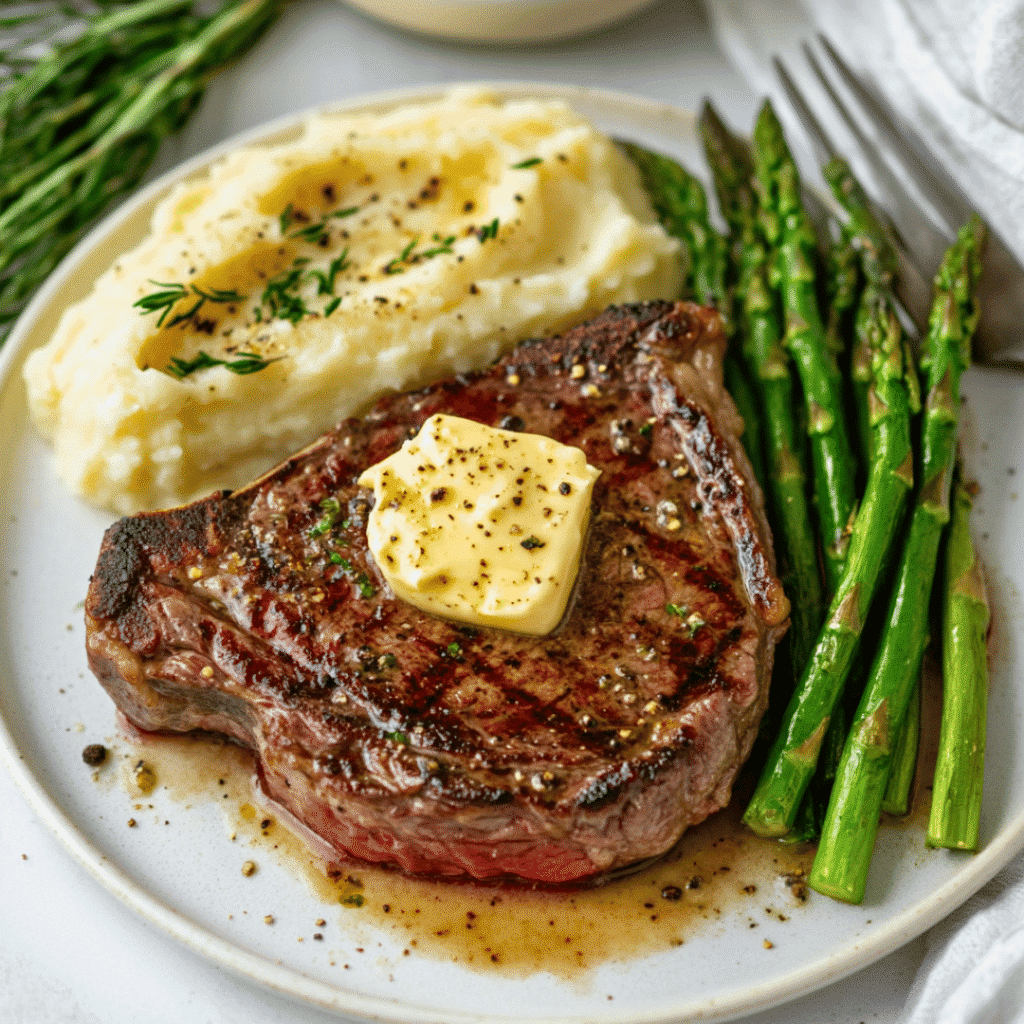
Sous Vide vs. Other Methods – Which Wins?
By now, you’ve learned how to cook a sous vide ribeye steak to absolute perfection. But how does it really stack up against traditional grilling? Steak lovers have strong opinions, and understandably so. Grilling brings nostalgia and smoke. Sous vide brings control and consistency. Let’s break it down and help you choose the right approach.
Sous Vide vs. Grilled: Which Is Better for Ribeye?
Here’s the honest truth: if you want a ribeye steak that’s cooked edge to edge, with zero guesswork and maximum tenderness, sous vide ribeye steak wins every single time. There’s just no other method that gives you that much precision.
Grilling, while beloved for its flame-kissed crust and smoky notes, has a downside—it’s easy to overcook. A ribeye can go from medium-rare to medium-well in less than a minute over open heat. That’s not a risk you take with sous vide. When your steak comes out of the water bath, it’s already cooked to the exact doneness you want. The final sear is all about flavor, not timing.
If you’re still wondering which is “better,” it depends on the experience you’re after. For a steak that’s reliable, juicy, and repeatable, go with sous vide. For a cookout vibe and that backyard char, grilled has its place—but be ready to watch it like a hawk.
Want both? Many chefs now sous vide their ribeye steak first, then finish on the grill. You get the best of both worlds: that smoky aroma with sous vide’s foolproof texture. You can see a great pro example of this hybrid method on ChefSteps for next-level results.
When to Choose Sous Vide Over Traditional Cooking
You don’t need a reason to make sous vide ribeye steak—but it shines in specific situations. Hosting a dinner party? You can cook five ribeyes at once, keep them warm for hours, and sear each to order. No stress. No dry steak. Just juicy, steakhouse results that blow people away.
It’s also perfect for meal prep. Want to enjoy a steak after work without standing over a grill? Batch-cook several ribeyes, chill them, and reheat sous vide-style any night of the week. Still pink. Still tender.
The same logic applies to other proteins. After falling in love with sous vide ribeye steak, try Scallops Sous Vide Frozen or even a leaner Sous Vide Flank Steak for weekday meals.
Sous vide isn’t just about ease—it’s about control. You’re not leaving anything to chance. That’s why serious home cooks and professional chefs alike rely on it. Once you master your sous vide ribeye steak, you’ll understand why it’s more than a trend—it’s a lifestyle.
FAQ Section about Sous Vide Ribeye steak
How long should I sous vide a ribeye steak?
1.5 to 4 hours is ideal depending on thickness; 2.5 hours at 129°F is perfect for medium-rare.
What temperature should ribeye steak be sous vided at?
Medium-rare: 129°F. Rare: 122°F. Medium: 135°F. Always match temp to desired doneness.
Do you sear steak after sous vide?
Yes. A hot sear adds flavor, texture, and visual appeal after sous vide cooking.
Is sous vide steak better than grilled?
For consistency and tenderness, yes. Grilling adds smoky flavor, but sous vide offers total doneness control.
If you’ve ever felt let down by an overcooked steak or rushed your grill game only to miss that perfect medium-rare center, sous vide ribeye steak is your solution. It gives you confidence, consistency, and a foolproof process for cooking one of the most luxurious cuts of beef. And the best part? It’s not just for pros.
Whether you’re entertaining guests or treating yourself to a quiet night in, the sous vide method gives you chef-level results with zero stress. Set it, walk away, then come back to a steak that’s juicy, tender, and ready for a killer sear. Once you’ve mastered it, grilling will feel like a backup plan.
Go try it. Fire up your circulator. Because one perfectly cooked sous vide ribeye steak might just change your kitchen forever.
Table of Contents
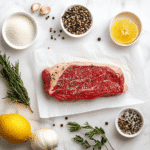
Sous Vide Ribeye Steak
- Total Time: 2 hours 35 minutes
- Yield: 1 steak 1x
Description
This sous vide ribeye steak recipe delivers perfectly even doneness from edge to edge with unbeatable tenderness. It’s easy, hands-off, and finished with a golden sear for steakhouse flavor at home
Ingredients
-
1 ribeye steak (1.5–2 inches thick)
-
1 teaspoon kosher salt
-
½ teaspoon freshly ground black pepper
-
2 cloves garlic, smashed
-
1 sprig fresh rosemary
-
1 tablespoon unsalted butter
-
1 tablespoon high-smoke-point oil (avocado, grapeseed, etc.)
Instructions
-
Preheat your sous vide water bath to 129°F for medium-rare doneness.
-
Season the ribeye generously with salt and pepper.
-
Place the steak in a vacuum-seal or freezer-safe bag with garlic, rosemary, and butter.
-
Seal the bag using a vacuum sealer or water displacement method.
-
Place the bagged steak into the sous vide bath and cook for 2½ hours.
-
Remove the steak from the bag and pat it dry thoroughly with paper towels.
-
Heat a heavy skillet (preferably cast iron) over high heat and add oil.
-
Sear the steak for 45–60 seconds on each side, including the edges, until a deep crust forms.
-
Rest for 2 minutes, then slice and serve immediately.
Notes
-
You can refrigerate the sous vide steak after the water bath and sear it later—perfect for meal prep.
-
For an even deeper crust, use a finishing torch or briefly sear on a hot grill after the pan.
-
Pair with compound butter, like my Cowboy Butter, for a bold finish.
- Prep Time: 5 minutes
- Cook Time: 2 hours 30 minutes
- Method: Sous Vide
- Cuisine: American
Nutrition
- Calories: 650
- Sugar: 0g
- Sodium: 500mg
- Fat: 52g
- Saturated Fat: 24g
- Unsaturated Fat: 26g
- Carbohydrates: 0g
- Fiber: 0g
- Protein: 48g
- Cholesterol: 160mg



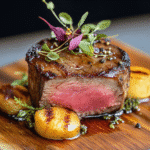

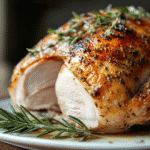



5 Comments
Comments are closed.